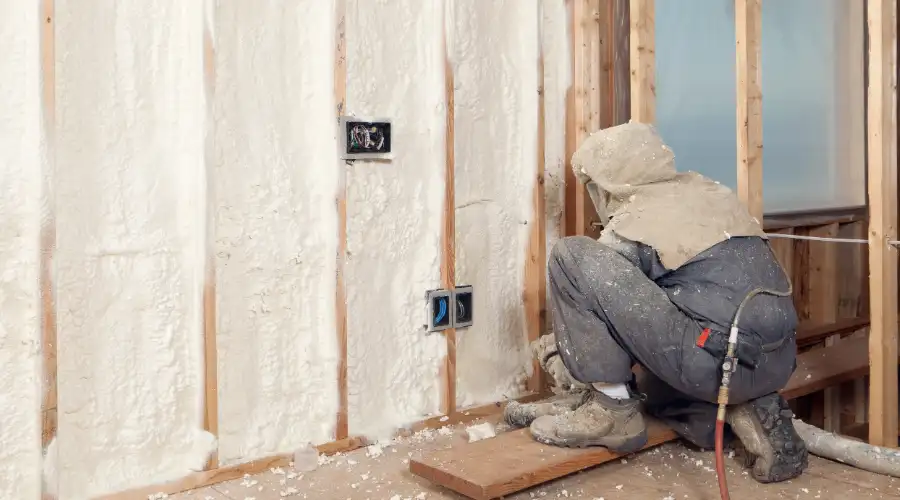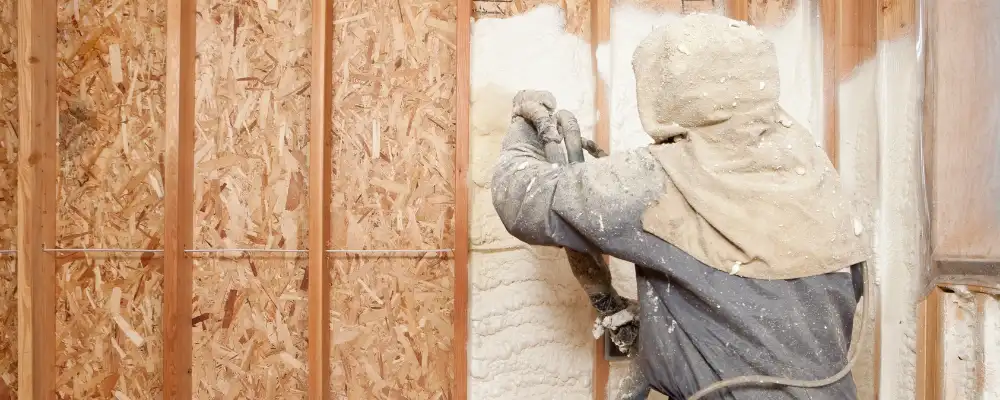Foam wall insulation is the best choice for providing better energy efficiency in buildings. It is the process of adding a layer of foam insulation to the interior, which helps in heat transfer reduction that results in the walls being cooler in summer and warmer in winter.
This characteristic of building insulation is the best solution for thermal energy preservation compared to traditional materials such as fiberglass insulation. Adding the right insulation to the walls, one can save energy that is equivalent to reducing greenhouse gas emissions.
This blog will help you understand foam wall insulation, its different types, and how to keep it effective.
What is Foam Wall Insulation?
Foam wall insulation is a highly technical method of controlling energy use in a structure by stopping heat from escaping the building and, in this way, utilizing energy without any waste. The most common materials for manufacturing foam wall insulation are spray or rigid foam boards, usually made from polyurethane or polystyrene. The use of its thermal resistance (R-value) from 6 to 7 for spray foam, as well as the good reputation of the support system, can prevent the rise of summer temperatures and loss of heat in the winter.
Besides excellent thermal resistance, foam wall insulation is an ideal air-sealing solution as it reduces air leaks and at the same time provides a higher level of indoor comfort. Moreover, closed-cell foam can also act as a vapor barrier, which will not let the water into the walls and stop them from producing mold. The sprayed foam product provides a tighter seal and fills voids and cracks due to its enlargement, thus it is suitable for both new construction and home renovations in pursuit of long-term energy savings and durability.
Pros and Cons of Foam Wall Insulation

Pros
- Energy Savings: The reflective nature of the insulation prevents heat from being soaked in the summer and keeps the house warm in the winter. This can save up to 30% of the energy bills.
- Water Resistance: Foam products are not open cells and therefore prevent moisture in place, ensuring the dryness of the area and the prevention of mold according to the mind region.
- Versatility: Foam insulation can be applied to many roof styles (even those having different geometries like domed, pitched, flat, metal, and concrete), and you could pick which ones the new or old roof will be suitable for.
- Improved Durability: The primary advantage of using foam insulation is that it can protect the roof’s structural integrity and has a significant impact on reducing the negative effects of temperature fluctuations.
Cons
- Superheating Risk: A poorly ventilated or unventilated space can become extremely hot if large amounts of heat are retained in a confined area.
- Health and Safety Risks: The green aspect of foam insulation is compromised because these materials, such as polyol resin and isocyanate, can pose health hazards if not handled by professionals, and thus, can cause safety problems unless precautions are taken.
- High Initial Cost: Installing foam insulation incurs a higher upfront cost than other insulation materials.
- Unpleasant Odour: If the installation process is not done in the right way, a fishy smell may be present in the home.
- Potential Mold Growth: Even though closed-cell foam is resistant to mold, it might still show surface mold growth if it is wet.
- Pest Concealment: The possibility of a foam wall insulation product covering up potential termite damage is also a concern, along with the difficulty of detecting the damage on time.
Overall, foam wall insulation is highly effective, but the cost and installation process should be considered carefully.
Types of Foam Wall Insulation
Various foam insulations for walls can be purchased based on different applications and installations.
1. Spray Polyurethane Foam (SPF)
SPF is made from a mixture of polyol resin and isocyanate, which expands when sprayed to create a solid foam. It is sprayed onto the wall as a liquid and expands into solid foam. The advantage of SPF is that it seals hard-to-reach nooks, corners, gaps, and cracks. It provides insulation and air sealing. It is found in homes and businesses, especially in odd-shaped spaces or complicated floor plans.
2. Pour Polyurethane Foam
A pour polyurethane foam is commonly used when there is a large void, similar to spray foam. Made from similar materials as SPF, pour polyurethane foam is used to fill large voids in walls. It is poured into cavities in a wall or spaces between studs, then expands and solidifies. Such foam insulation is used in foundation walls and areas needing uninterrupted insulation.
3. Injection Foam
Injection foam, often made from polyurethane, is injected into existing wall cavities to fill gaps and improve insulation without significant structural disruption. This technique is particularly suitable for homes with poor insulation. Without causing major structural damage to the space, it fills the hole in the wall.
4. Foam Board Insulation
Foam boards are made from materials like polystyrene, polyisocyanurate, or polyurethane. These are solid panels of foam that are cut to fill the cavity of the wall. This type of insulation is frequently installed outside walls and basement areas. That’s where moisture exposure is common because the panels provide a moisture-resistant barrier.
5. Can Foam
Typically made from polyurethane, can foam (or spray foam in a can) is a convenient, ready-to-use solution for small gaps and cracks. Commonly used for small projects or specific areas. So it’s a great portable solution. There is no need to wait for this product to dry; it dries quickly.
Considerations Before Installation
Before installing foam wall insulation, make sure to take into account the following considerations to get the best product performance and value.
- Type of Foam Insulation
Opt for foams depending on the area and construction of your walls. For example, spray foam is good for odd-shaped nooks and crannies, and foam boards are good for flat, uniform areas.
- Cost
Foam insulation, particularly spray foam, has a higher initial cost compared to fiberglass, but its superior energy efficiency leads to significant savings on heating and cooling costs over time, making it a cost-effective long-term solution.
- Installation Method
Consider whether you’ll hire professionals or do it yourself. Spray and pour foam requires professional installation, whereas foam boards and can foam can be installed by motivated DIYers.
- Environmental Impact
Choose less Volatile Organic Compounds (VOCs) and Global Warming Potential (GWP) eco-foam options to keep a clean, eco-friendly environment.
- Existing Insulation and Building Conditions
Deal with any kind of pre-existing moisture or mildew complications first, or you risk trapping moisture in walls behind the foam.
- Local Regulations
Make sure the foam you choose complies with local fire and building codes.
By comparing these factors, you can choose the best foam insulation for you. One that will give years of superior performance and energy savings.
Installation process of foam wall insulation
Here’s a step-by-step process for installing foam wall insulation,
1. Preparation
- Clear the area of debris and old insulation and make sure the walls are dry and there are no mold or water damage issues.
- Inspect the walls for structural cracks or gaps and seal them off before insulating the walls.
2. Spray Polyurethane Foam (SPF) Application
- A licensed contractor applies the insulation by spraying the foam onto the walls utilizing special spraying equipment. The foam will expand and solidify while filling gaps, cracks, or voids.
- It will be necessary to cure the foam after it has been soaked for a few hours. If the surface needs to be feathered or trimmed after curing, you can do so.
3. Foam Board Insulation Application
- Cut the foam boards so they fit inside the cavity wall, and attach them using adhesive or mechanical fasteners.
- Seal the joints between boards with either foam sealant or tape to prevent air leakage.
4. Injection Foam insulation
- You will have small holes drilled into the wall, in greater quantities, and drilled between the studs as well.
- The foam is injected into the wall cavities, and it expands and cures to create a sealed barrier.
5. Post-Installation
- After installation, patch drilled holes, inspect for gaps, and allow the foam to cure fully.
- Once curing is complete, proceed with installing drywall or other wall coverings to complete the energy-efficient insulation process.
Maintenance and Longevity
- After a storm or some construction, check for any new gaps, cracks, or damage. And, check seals around windows and doors to keep out air and water.
- If there are any sources of moisture (leaks or condensation), note these and work to stop mold growth. Keep ceilings, basements, and attics ventilated to reduce moisture.
- Environmentally based contaminants could pose some risks to the performance of foam insulation, and this should be addressed. Do not cause physical damage to it, and avoid squeezing the insulation, as this can compromise its performance.
- It’s always best to consider replacing insulation. Spray foam insulation might have an anticipated life of maybe 20-30 years, and foam boards could last even longer with proper maintenance. Be conscious of areas where there might be more moisture to watch for signs of degradation.
- One sure evidential marker for needing to repair foam insulation is when you find foam that has been damaged or shows signs of degradation.
Doing these will help keep foam wall insulation working well and keep its replacement period farther down the road.
Conclusion
Foam wall insulation does more than just save you energy. It also provides increased resistance to moisture, comfort, and clean air inside your house. Besides that, such timely maintenance will enable it to serve you for a couple of decades, ensuring not only savings for you but also the prevention of the pollution of indoor air. You can contact Brick & Bolt today with any foam insulation needs. We help you by providing expert advice and professional installation that will, in turn, enhance your space’s energy efficiency and comfort.

